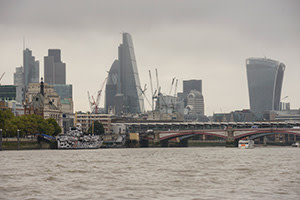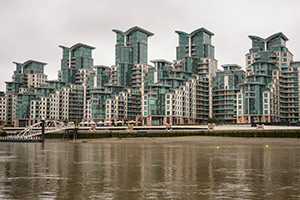City’s former planning chief on why London is ‘unplannable’
Simply sign up to the Life & Arts myFT Digest -- delivered directly to your inbox.
About a year after the residents of The Heron in the City of London moved into their glistening new skyscraper, they decided to form a residents’ association. Yet when they tried to gather support for the idea among their fellow tower dwellers, they encountered a problem: they couldn’t find half of the residents.
“They hadn’t even picked up the keys 12 months on,” says Peter Wynne Rees. “If that isn’t an indication of their motive for buying a property, I don’t know what is.”

Rees, who not only lives in the building but guided its planning application in his previous role as the City’s chief planner, offers the vignette as a prime example of what he believes is wrong with the capital’s property market: speculative foreign investors are flooding in, pushing out locals with cash purchases and exacerbating the city’s housing shortage by leaving their homes empty. Now a professor of places and city planning at the Bartlett School of Planning in Bloomsbury, Rees is freer to speak his mind than in his 29 years as a planning official in the City of London Corporation, the Square Mile’s local authority. And his opinions on the city he has helped to shape are fluent, informed and often scathing.
Dressed in a casual jacket and jeans – but with an air of authority underscored by his height and commanding voice – Rees is waiting on the banks of the Thames next to the Tower of London. We are embarking on a boat operated by the Port of London Authority for a journey inspired by Rees’ City days, when he would often take town planners visiting from overseas on a river trip to show them what he thought worked on London’s skyline – and what did not.
Under a slate-grey sky, he begins by turning to face the City, whose recent crop of towers – all of which he approved – seem to loom larger at river level.
Rees says it was in his role as head planner that he “put the fun” in the City, ushering in a wave of bars, nightclubs and restaurants that revived the evening economy of the staid finance centre. He recalls the scene on London Bridge in the 1980s, when “miserable” commuters with bowler hats and unfurled umbrellas would rush back to London Bridge station at 5:30pm on the dot to get back to their suburban homes, leaving the City largely empty.
“Now we have bars and clubs open to four in the morning. On a Saturday night there are stretch limos all the way from Cornhill to Essex.” The City remains an unapologetic citadel of business, he adds, but one to which young people are now attracted as a social hub as well as a place of work.
For a man who approved the Gherkin, the Cheesegrater, the Walkie-Talkie and The Heron, however, Rees is curiously hostile to the prospect of tall buildings rising elsewhere in the city – more than 200 have planning permission, according to a recent estimate. However, he rejects any suggestion of hypocrisy.
“If you must build tall – and you should only build tall if you run out of land – then the two things you must do are build distinguished buildings by good architects and group them together to minimise their environmental impact. And that hasn’t happened.”

Yet having bought a flat for himself in a glass-and-steel residential tower that breaks the City’s tradition of business-only construction, how can Rees castigate developers about their high-rise plans? He replies that the argument is not about ownership but occupancy – and he lives full-time in his apartment.
As we head up river, it begins to drizzle steadily and we take more care with our footing around the exposed boat deck. Yet Rees’s enthusiasm for buildings he likes – and his opprobrium for others – is barely damped. He declares the newly remodelled Blackfriars Railway Bridge, now festooned with solar panels that provide half its energy, a paragon of city planning in its upgrading of Victorian infrastructure with cutting-edge technology.
As we pass under the bridge, though, he turns less respectfully towards South Bank Tower, which is being turned from a business block into homes and raised from 30 storeys to 41. “It’s a stump being extruded upwards,” he says, regretting the increasing loss of office space as returns from residential development have greatly outstripped those from commercial property.

Cities benefit from having the classic 25-year lease on commercial buildings, he argues, allowing them to be refurbished or updated when the term ends. But the leases on homes typically run for 125 years, leaving London far longer to rue the consequences of a decision sometimes made in haste. “We’re losing land we can’t afford to lose,” he says.
What land we have left is wasted on residential towers, he adds, arguing that the City’s skyscrapers can be packed in tight, since office workers are not there to look out of the window. Yet residential towers must be spread out more widely, making for far less efficient use of land.
His claims about the preponderance of foreign investors have not been left unchallenged. Research last year by Christine Whitehead, a professor at the London School of Economics, suggested that while international investors were buying a large proportion of new-build property in prime areas of central London, this accounted for only a small part of total demand – 6.5 per cent across the city. Some 80 per cent of sales were paid for by UK mortgages, and of the rest, the majority was “overwhelmingly domestic cash sales”, said the report, which was commissioned by Berkeley Homes.

London’s underlying housing problems nonetheless seem intractable, in spite of recent signs of a cooling market. House prices in the capital have risen just under 20 per cent over the past year, according to the Office for National Statistics. Politicians, business groups and charities are in agreement that the capital’s homes are increasingly out of reach for average earners, and yet construction stubbornly lags behind demand.
The capital’s biggest building site, with 18,000 homes planned, may provide part of the solution. At Battersea Power Station in the Nine Elms district, Malaysian money is helping to transform the crumbling power station and its surroundings. Leading architects such as Frank Gehry and Rafael Viñoly have been brought in. The government has backed a new Tube extension. Things are finally moving in an area that was left to dereliction for decades. Could this example of urban regeneration provide the counter argument to Rees’s concerns?

Not likely. “Nine Elms is really a slum for rich people,” he says. High-margin residential dwellings will be favoured over business construction, choking life out of the district, he predicts, and views of the river are likely to be restricted, with the architecture constrained by its neighbours. “[They will be] hemmed in among other undistinguished buildings, almost as if they are hulks that have run aground on the river.”
It is clear what Rees thinks is going wrong with London: over-mighty developers, weak councils, bland architecture, too much foreign money and politicians desperate to demonstrate action. Yet, as we head back downriver to disembark outside the Globe Theatre, the question remains: what should a planner do? Those who have tried to impose distinct functional zones on cities have mostly been doomed by the sporadic, spontaneous nature of urban growth. Rees would like to “tidy the place up”, but he knows this would kill it.
London’s attraction, he says, is its ability to absorb people who don’t easily settle in their native environment – “people like me, who didn’t fit into their small south Wales community”. But when enough of such people gather together, a surge of creativity is likely to follow. “The greatest thing about London is that it’s unplannable. The worst thing about it is that it’s unplanned.”
James Pickford is deputy editor of FT Money
Photographs: Richard Nicholson
——————————————-
Letters in response to this article:
Walkie Talkie makes this tower moan all a bit rich / From Andrew Hamilton
Nine Elms development is great news for Londoners / From Ravi Govindia
Comments